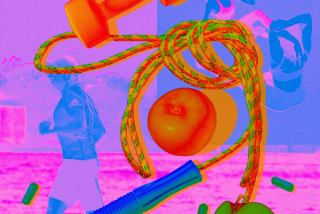The Good Food, the Bad Food and the Ugly Quarrel
- Share via
Rank these foods as either good or bad:
Lard.
Carrots.
Chocolate doughnuts.
Whole-wheat bread.
When it comes to selecting foods by nutritional quality, lard and doughnuts sound pretty evil, and carrots and whole-wheat bread seem far more pristine.
Right? Wrong, say a growing number of nutrition educators, food-industry executives and government officials, who have turned the statement “There are no good foods or bad foods, only good diets and bad diets” into a kind of dietary mantra.
Many believe that this oft-repeated phrase is the best way to introduce the messages of variety and moderation, to assuage the public’s guilt over indulging occasionally and to promote flexibility in food choices.
At the same time, it brings up the problem of how to teach Americans to make trade-offs in their diets and how to guide them healthfully through a food supply that is constantly changing and constantly tempting.
The concept reappeared recently with the release of the U.S. Department of Agriculture’s Food Guide Pyramid, a graphic that will be used to teach Americans what and how much they should eat from each food group.
In part, the project was put on hold last year after meat and dairy groups feared that the positioning of their foods near the narrow top of the pyramid would make people think these foods were “bad,” as opposed to the “good” grains and produce along the broad base. Subsequent consumer research has shown that this was not the case.
“Any food can be part of a healthful diet,” said Ann Chadwick, acting assistant secretary for food and consumer services at the USDA. Chadwick said the structure of the pyramid “allows consumers to make their own choices.”
“When people begin to put foods into categories, it skews foods that mean a lot to you,” said Judy Dodd, president of the American Dietetic Assn. “If people like their greens cooked in fatback and you tell them to steam them, you’re telling them what they’ve been doing all their lives is wrong.”
At the same time, there is a growing debate within the nutrition community as to whether this type of advice is really so “good.”
“Suddenly there’s a new dogma among nutritionists that we’re not supposed to say that any foods are ‘good’ or ‘bad,’ ” said Isobel Contento, professor of nutrition at Teachers College at Columbia University. “How do you know your diet is good? You eat more good foods than bad foods. How do you know that your diet is bad? You eat more bad foods than good foods. At some level, you can’t get around the fact that some foods are better for you than others. At some point, you have to give (consumers) guidance.”
Contento fears that the good-food bad-food phrase will be used by the food industry to justify the premise that all foods are equally nutritious.
So does Bonnie Liebman, director of nutrition at the Center for Science in the Public Interest, an advocacy group. “Nobody thinks about what it means,” Liebman said. “What it means is nonsense. The fact is this is just an excuse by the food industry to continue selling junk foods and protect them from criticism.”
Gary Wilson, director of research and education at the National Cattleman’s Assn., believes that there aren’t any foods that provide all the essential nutrients, and he doesn’t know of any commodity groups that claim all foods are equal.
“Beef isn’t equal to celery in fiber,” he said. “Beef contains no fiber. If fiber is an issue, you should eat celery along with a 3-ounce portion of beef. On the other hand, if Vitamin B12 is the issue, you’d better be having a little beef with your celery stick.”
Either scenario keeps you eating beef, but some nutritionists and researchers believe that pegging foods such as red meat as “bad” has led some people to avoid it entirely.
In fact, food consumption surveys show that the same people who are avoiding red meat are also eating a lot of cheese and salad dressings, so that the total fat in their diets remains virtually unchanged.
That may be the reason nutritionists are rallying behind the “no good foods, no bad foods” phrase, Contento said. Still, by repeating it, they “may be adding another level of confusion.” It would be better “to correct the misapplication of the original notion (that there are good foods and bad foods) than to do away with it altogether,” she said.
More to Read
Eat your way across L.A.
Get our weekly Tasting Notes newsletter for reviews, news and more.
You may occasionally receive promotional content from the Los Angeles Times.










